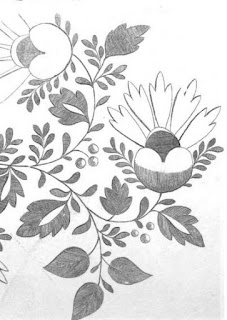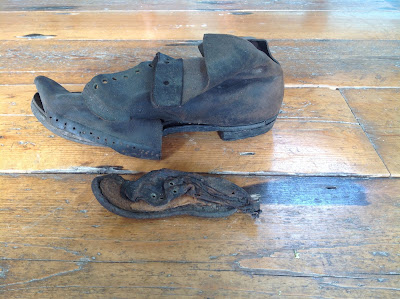No Place for Idle Hands-Part 2
The difference between the work of women and men in Irish workhouses
- · Embroidery
- · Knitting
- · Making socks, shawls, handkerchiefs & other items of clothing
- · Lace-making
- · Crochet
- · Quilting
- · Netting
- · Flowering & Sprigging
The above list shows the variety of skilled needle-work
performed by female paupers. Note the
inclusion of a type of needlework which is largely forgotten today; flowering and sprigging. This entails the
embroidering of muslin with small sprays of foliage or floral patterns.
Many different patterns could be used and were widely circulated in periodicals. In an era before the ready availability of printed fabric, a huge volume of labour was required to supply the demand for this kind of needlework. Below we can see a popular muslin pattern from R. Ackerman's Repository of Fashions 1829, which shows a fashionable flowering/sprigging design.
Many different patterns could be used and were widely circulated in periodicals. In an era before the ready availability of printed fabric, a huge volume of labour was required to supply the demand for this kind of needlework. Below we can see a popular muslin pattern from R. Ackerman's Repository of Fashions 1829, which shows a fashionable flowering/sprigging design.
Men were engaged in a different selection of industrial activity. 125 out of 163 workhouses (just over 75%) provided their
young male paupers with some sort of industrial training. The skills that were
taught included agriculture, shoe-making, tailoring, weaving, baking, carpentry
and tin-smithing.
In the 1852 Return to Parliament which lists the kinds of
employment at all 163 workhouses, we see that 89 Unions made their own shoes,
which appears to be one of the most common skilled jobs given to male paupers.
Strabane even had extra to sell!
There are also numerous mentions of weaving and
carpentry, with several entries for smithing of some kind, such as tin-ware
making, and nail-making. Even coopering (barrel making) is mentioned in several
workhouses. However, much of this labour was
simply to supply workhouse demand rather than for sale to outside
parties.
By
1852, most workhouses were keeping down
food costs by growing their own crops. In figures from that year we can see
that 137 workhouses engaged in crop cultivation, growing produce such as oats,
barley, cabbage, parsnips, mangel-wurzel (a type of giant beet), onions, wheat,
corn, green-crops, and potatoes.
There were even model farms at Rathkeale and Carrick-on-Suir workhouses in Co. Limerick. In fact, 57 of the 137 farming workhouses had surplus produce which they sold and 50 workhouses employed an Agriculturist to teach farming to workhouse boys as part of their industrial training.
There were even model farms at Rathkeale and Carrick-on-Suir workhouses in Co. Limerick. In fact, 57 of the 137 farming workhouses had surplus produce which they sold and 50 workhouses employed an Agriculturist to teach farming to workhouse boys as part of their industrial training.
Despite political views to the contrary, Irish paupers could be highly skilled craftspeople,
readily taught students and diligent workers, a fact which is often overlooked
in the story of Irish workhouses. Despite the fact that parliamentary
legislation strove to curtail all skilled activities in Irish workhouses,
inmates produced goods which were sold to private individuals, at markets, at
auction and shipped overseas to 'Belgium,
Germany and France' (The Nation Newspaper, 1853).
Some
workhouses even filled contracts for manufacture, sending embroidery, textiles
and clothing to suppliers. These items were light weight and easy to transport
which is perhaps why they outnumber other types of crafts when it comes to
commercial interest.
Another factor may simply be that needle-work was largely a female task at this time, and there were significantly higher numbers of able-bodied women compared to men in the workhouses. In 1852 there were more than double the number of able-bodied women to men in Irish workhouses.
Another factor may simply be that needle-work was largely a female task at this time, and there were significantly higher numbers of able-bodied women compared to men in the workhouses. In 1852 there were more than double the number of able-bodied women to men in Irish workhouses.
All of Ireland
Total Able-bodied Males: 19,353
All of Ireland Total Able-bodied Females: 45,814
As new research sheds light on the skilled crafts which
were carried out in Irish workhouses, we need to realise that perhaps life was
more varied in these institutions than the Poor Law legislation would have us
believe. Certainly, there is a wealth of manufacture that has been completely
unacknowledged which is a great shame.
We will never look back with fondness on the
workhouse system, but never the less, it's important to recognise the
ingenuity, skill and determination of its inmates. Our next big question is
whether any of the baskets, floor mats, shirts, embroidery or pieces of fine
lace have survived, or are the products of these 'Houses of Industry' lost to
us forever.
By Elizabeth Carter



Comments
Post a Comment